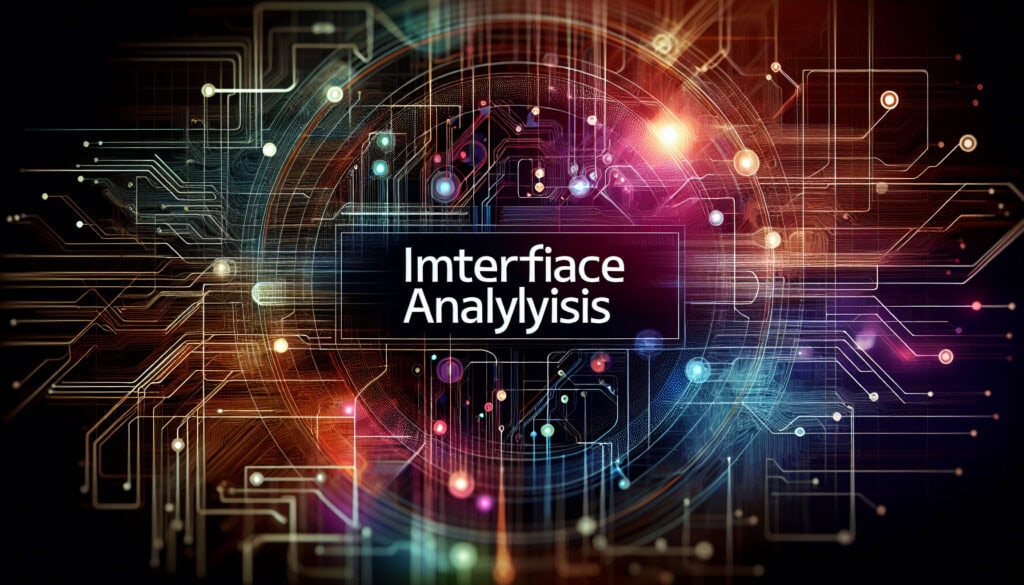Identifier et analyser les interfaces entre différents systèmes ou composants.
- Méthodologies : Clients et marketing, Économie, Lean Sigma, Fabrication, Gestion de projet, Qualité
Analyse de l'interface

Analyse de l'interface
- Interface de programmation d'applications (API), Conception pour la fabrication (DfM), Optimisation de la conception, Interaction homme-machine, Système de gestion de la qualité (SMQ), Langage de modélisation des systèmes (SysML), Expérience utilisateur (UX), Interface utilisateur (UI)
Objectif :
Comment il est utilisé :
- A systematic process for identifying and analyzing the interfaces between different systems, subsystems, or components. It is used to ensure that the interfaces are complete, consistent, and well-defined.
Avantages
- Helps to ensure that systems will work together correctly; Can identify potential integration problems early in the development process.
Inconvénients
- Can be time-consuming and complex to perform; Requires a deep understanding of the systems being analyzed.
Catégories :
- Ingénierie, Gestion de projet
Idéal pour :
- Ensuring that different systems or components will be able to communicate with each other effectively.
Interface Analysis plays a significant role in the design and development of interconnected systems within various industries such as aerospace, automotive, software development, telecommunications, and robotics. This methodology is typically applied during the system engineering phase of a project, particularly when multiple teams or stakeholders are involved in creating components that will interact with one another. It encourages collaboration among engineers, designers, and project managers to create a comprehensive understanding of how interfaces will function and be utilized. Initiating this process often involves system architects or lead engineers who facilitate workshops or discussions to map out the interaction points, ensuring that design specifications are aligned with integration requirements. Throughout the cycle de vie du produit, Interface Analysis can be revisited, particularly during the verification and validation stages, when prototypes are tested to confirm that all systems communicate as intended. This approach not only identifies compatibility issues early on but also lays the groundwork for robust documentation that can streamline future maintenance and upgrades, making it easier for teams to implement changes without disrupting existing functionality. Applications include developing communication protocols for IoT devices, ensuring safety standards in automotive systems, or coordinating software modules in a cloud infrastructure, all of which require meticulous attention to how individual components will process and share information.
Principales étapes de cette méthodologie
- Identify systems, subsystems, or components that require interface analysis.
- Define the functional requirements for each interface.
- Document current interface specifications and standards.
- Analyze the interactions between systems or components, focusing on data flow and control.
- Identify potential conflicts or incompatibilities in interface design.
- Develop interface design solutions that address identified issues.
- Iterate the design based on feedback and testing outcomes.
- Verify interface compliance with defined requirements.
Conseils de pro
- Utilize model-based systems engineering (MBSE) to create a visual representation of interfaces, enhancing clarity and communication across all teams involved.
- Conduct interface control document (ICD) reviews regularly throughout the development lifecycle to verify adherence to interface specifications and standards.
- Implement rapid prototyping of interfaces to test interoperability early, allowing for quick identification of discrepancies and iterative refinement before full-scale production.
Lire et comparer plusieurs méthodologies, nous recommandons le
> Référentiel méthodologique étendu <
ainsi que plus de 400 autres méthodologies.
Vos commentaires sur cette méthodologie ou des informations supplémentaires sont les bienvenus sur le site web de la Commission européenne. section des commentaires ci-dessous ↓ , ainsi que toute idée ou lien en rapport avec l'ingénierie.
Contexte historique
1980
1980
1986
1987
1990
1990
1990
1980
1980
1986
1986
1987-03
1990
1990
1992
(si la date est inconnue ou n'est pas pertinente, par exemple "mécanique des fluides", une estimation arrondie de son émergence notable est fournie)















Articles Similaires
Simulation de Monte Carlo
Tests basés sur des modèles
Contrôle des modèles
Recherche sur les méthodes mixtes
À l'épreuve des erreurs (Poka-Yoke)
Test du profil de la mission